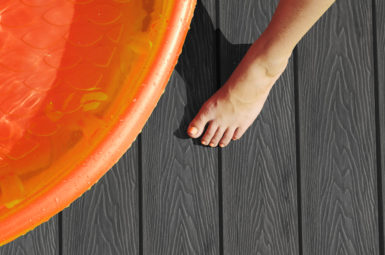
Whether you have natural wood or composite decking, keeping your deck looking its best, as well as safe and slip free, requires upkeep.
If you notice your decking getting slippery or looking lackluster, it might be time to give it some TLC. In this article, we take a look at six quick fixes and preventative measures for slippery decking.
To prevent slippery decking, it helps to understand the cause of the issue. The most likely reasons for slippery decking are:
Algae, mould, or moss build-up
Ineffective drainage/dirt in between boards
Poor maintenance
Often, one issue will lead to another, making a slippery deck more difficult to resolve. Protecting your decking from the elements is the best way to prevent these issues from arising in the first place, whilst prolonging its lifespan. Ensure your decking always looks at its best with the following tips.
If you're considering a DIY approach to decking, it’s important to remember that incorrect installation can affect its performance and lead to problems. A common mistake is not leaving adequate and equal spaces between each board.
Poor installation leaves water and debris with nowhere to go, leaving these trapped on your deck. Without adequate draining, even maintenance can be a double-edged sword. Cleaning or brushing your deck can push debris further into these small gaps, making drainage issues worse.
We recommend you consult with a professional before undertaking your project. If you do decide to go down the DIY route, make sure you are familiar with the product you are using and that you have a full understanding of the installation process.

Outdoor decking of any type requires maintenance. Small amounts of regular upkeep can help protect your deck from damage and prevent your deck from becoming overly slippery.
Regularly use a soft-bristled brush to sweep your decking - doing this weekly removes any debris such as leaves and dirt. Then every few months, and at least twice annually, treat your decking with a specialised cleaner to prevent severe build-up.
If you're struggling to maintain your decking, read our blog on how to clean composite decking for more tips.
Exposure to wet weather can cause surface dirt and water to trap in the grooves of your decking. If it's been a while since you last cleaned your deck, moisture and dirt could be breeding mould, moss, or algae.
To treat your decking and remove buildup we recommend a bleach-free, mould, and algae remover. Mix as per the directions and allow the solution to sit on the decking for roughly 30 minutes. Scrub the decking with water and a soft-bristled brush to avoid scratches - any substance should then lift away. For stubborn, organic staining, we recommend the Pavetuf Green-Off Cleaner, which is a specialist cleaner designed to tackle this type of staining.
Any external structures will be prone to algae build-up, no more so than hot tub or swimming pool decking. Regular maintenance can help prevent this, however, anti-slip mats provide additional safety for steps and waterside areas.
Adding mats is also an ideal solution for those who want to childproof their decking. They’re also easy to remove for quick and easy cleaning to prevent the spread of moss or algae.
A more discreet alternative is anti-slip tape. Perfect for steps or other areas that may pose a slip hazard. The beauty of this tape is that it comes in a range of widths with pieces cut to fit, giving you as much or as little grip as you require.
Application is easy with self-adhesive weather-proof tape, or for a firmer fit, some tapes can be nailed to the decking itself. Usually available in black, grey, or brown, it's easy to coordinate the tape with your decking to achieve the desired look without compromising on safety.
A more permanent way to limit slippery decking is to opt for composite, rather than timber. Most composite decking has anti-slip qualities built-in, providing added safety in all weather conditions. Additionally, the extra durability of a composite alternative means your decking is not susceptible to rot and warping during wet winter months.
In addition to its anti-slip properties, composite decking also has several other benefits - below we have outlined some of the advantages and disadvantages of composite:
Advantages of Composite Decking
Longevity and Durability
Eco-friendly (Piranha Decking is made from recycled materials and is FSC Certified.)
Quality investment
Low maintenance
Slip-resistant
No painting or staining required
Easy to clean
Will not rot, warp or split
Disadvantages of Composite Decking
Costly upfront investment when compared to natural timber boards
Can't be repainted or 'stained' if a different colour is desired after installation
Some products on the market can lack the 'real' wood effect
To understand if composite decking is the right choice for your project, we recommend reading everything you need to know about composite decking.
Considering composite decking for your next project? If you’re ready to start building your dream garden, so are we. Our expert installers can help you achieve your garden goals whatever your style.
We also offer sample packs to help you choose your perfect deck. If you need some more guidance on composite decking our Knowledge Hub is packed with helpful information.
